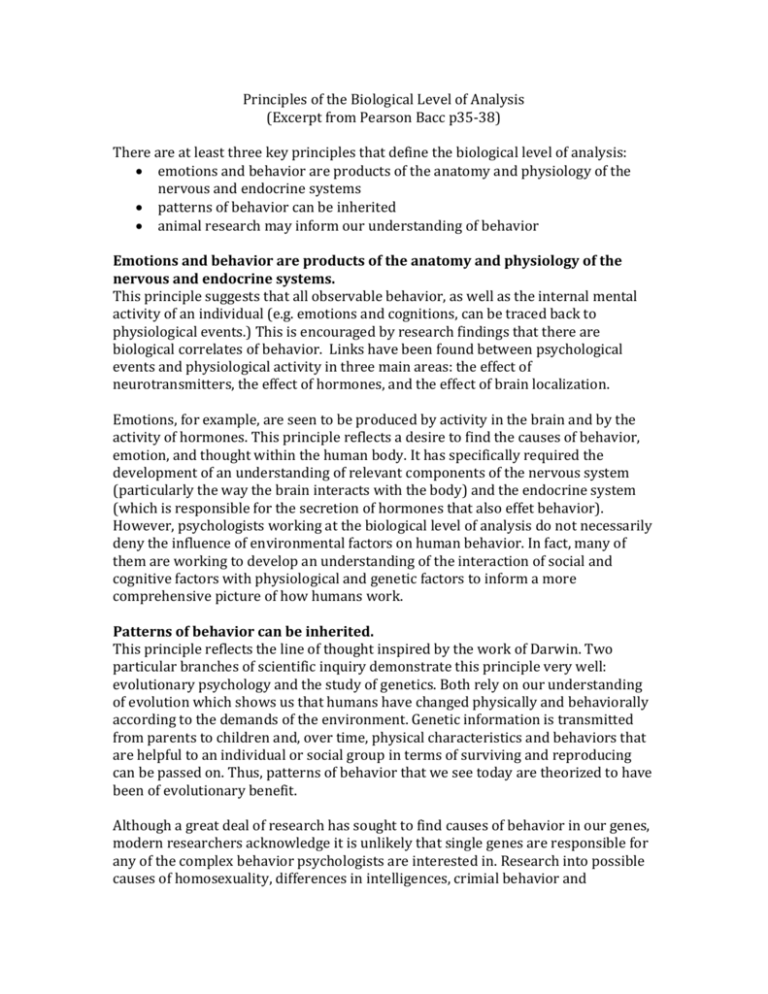Principles of the Biological Level of Analysis (Excerpt from Pearson
advertisement

Principles of the Biological Level of Analysis (Excerpt from Pearson Bacc p35-38) There are at least three key principles that define the biological level of analysis: emotions and behavior are products of the anatomy and physiology of the nervous and endocrine systems patterns of behavior can be inherited animal research may inform our understanding of behavior Emotions and behavior are products of the anatomy and physiology of the nervous and endocrine systems. This principle suggests that all observable behavior, as well as the internal mental activity of an individual (e.g. emotions and cognitions, can be traced back to physiological events.) This is encouraged by research findings that there are biological correlates of behavior. Links have been found between psychological events and physiological activity in three main areas: the effect of neurotransmitters, the effect of hormones, and the effect of brain localization. Emotions, for example, are seen to be produced by activity in the brain and by the activity of hormones. This principle reflects a desire to find the causes of behavior, emotion, and thought within the human body. It has specifically required the development of an understanding of relevant components of the nervous system (particularly the way the brain interacts with the body) and the endocrine system (which is responsible for the secretion of hormones that also effet behavior). However, psychologists working at the biological level of analysis do not necessarily deny the influence of environmental factors on human behavior. In fact, many of them are working to develop an understanding of the interaction of social and cognitive factors with physiological and genetic factors to inform a more comprehensive picture of how humans work. Patterns of behavior can be inherited. This principle reflects the line of thought inspired by the work of Darwin. Two particular branches of scientific inquiry demonstrate this principle very well: evolutionary psychology and the study of genetics. Both rely on our understanding of evolution which shows us that humans have changed physically and behaviorally according to the demands of the environment. Genetic information is transmitted from parents to children and, over time, physical characteristics and behaviors that are helpful to an individual or social group in terms of surviving and reproducing can be passed on. Thus, patterns of behavior that we see today are theorized to have been of evolutionary benefit. Although a great deal of research has sought to find causes of behavior in our genes, modern researchers acknowledge it is unlikely that single genes are responsible for any of the complex behavior psychologists are interested in. Research into possible causes of homosexuality, differences in intelligences, crimial behavior and pyschological disorders such as schizophrenia, has been motivated by the hope that finding a genetic component will hep us understand human experience better. More and more, researchers are finding that what is inherited may be a predisposition for certain behvaior that requires particular evironmental stimuli before the behavior will become manifest. For example, the diathesis-stress model of abnormal behavior suggests that a genetic vulnerability to disorders like depression can be inherited, but that an environmental trigger like childhood separation or a traumatic divorce is required for the person to actually become depressed. Animal research may inform our understanding of behavior. One of the key assumptions of a biological approach, based initially on Darwin's work, is the idea that humans and the many types of animal are different species now because of thousands of years of evoultionary adaptation to environmental demands. This suggests that we share an earlier common ancestral species and, in many ways are fundamentally the same; the human being is a type of animal. When it comes to studying physiology and behavior, therefore, it is valid to try to make inferences about human behavior based on animal research, because the mechanisms that underlie behavior are the core similarity we share with animals. Brains can be studied in animals that appear to be quite closely related to humans, such as monkeys and apes. It is also possible to make generalizations from studies that manipulate levels of specific neurotransmitters in the brain of other mammals rats, for example. it has also been extremely useful to observe evolution in manageable contexts with animals that have much shorter lifesans than humans (e.g. fruit flies and foxes) and to assume that the same processes apply to humans. **There is significant controversy about the use of animals in research and it is important to understand the advantages and disadvantages of this type of research.










